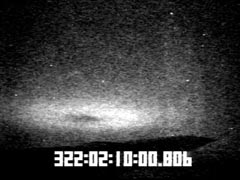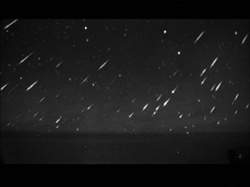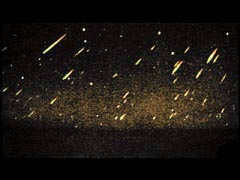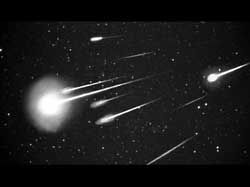
An unusual image of an "elve"
captured by M.J. Taylor and L.C. Gardner of the Space Dynamics
Lab., Utah State University, during the night of the Leonids storm at 02:10:00 UT.
Still images
Two meteors against the backdrop of the long lasting persistent train from the 3h13m10s UT fireball, as seen from ARIA in the constellation of Columbo
at 2:21:09 UT. Courtesy: Peter Jenniskens.
This airglow image
by M.J. Taylor and L.C. Gardner shows regular and chaotic structure in the upper atmospheric OH nightglow emission layer (altitude ~87 km).
Joe Kristl and Mike Taylor of Space Dynamics Lab.
present a sequence of images of a near infrared meteor
observed with the NRL InGaAs camera flown on the FISTA aircraft.
This images shows the spectrum of a bright afterglow by
Jiri Borovicka. Another afterglow spectrum was obtained by
Peter Jenniskens/Mike Wilson. The
meteor was imaged from ARIA and occured at 04:00:29 UT.

1999 Leonid storm as seen from Leonid MAC with 28 mm camera. Photo: Shinsuke Abe and Hajime Yano, ISAS.
|

Leonid storm live on internet, as seen from
ARIA. Image courtesy: Japanese Broadcasting Company (NHK)/Hajime Yano ISAS.
Still images
This graph
shows the live flux measurements reported at this website during
the 1999 Leonid meteor storm (courtesy: Glenn Deardorff)
This rate curve are 1-minute counts by
Dutch Meteor Society observer Koen Miskotte, who observed from one of two ground
campaigns in Spain.
Leonid flux
as reported live by the LEOC at Marshall Space Flight Center,
which coordinated the reporting of flux to satellite operators (Image courtesy: LEOC,
MSFC)
NASA/Ames Astrobiology Academy student Matt Lacey, currently at Stanford University,
took this unusual spectrum of a
persistent train (raw data) of a not quite so
bright Leonid at 03:34:12 UT, some tens of seconds after the train formed.

1999 Leonid storm as seen from Leonid MAC with 50 mm camera. Photo: Shinsuke Abe and Hajime Yano, ISAS.
|
